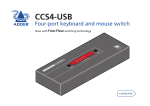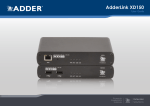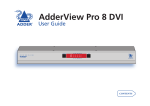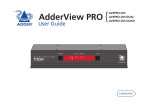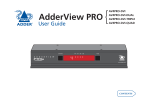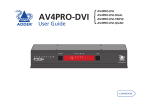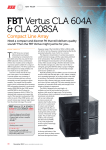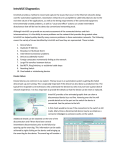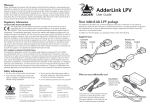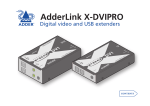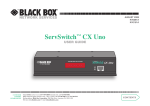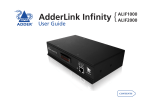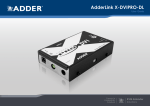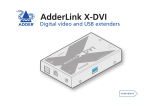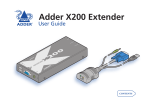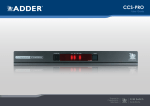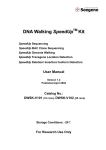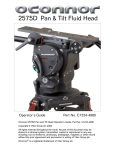Download Adder CCS4-USB
Transcript
Adder CCS4-USB Four-port keyboard and mouse switch Operation Selecting a computer.................................................................14 To select a computer using the control panel......................14 To select a computer using hotkeys......................................15 To select a computer using the mouse buttons...................16 Further information Getting assistance.......................................................................17 Appendix 1 – Cable pin-outs......................................................18 Safety information.....................................................................19 Warranty.....................................................................................19 Locations.......................................................................................6 Mounting......................................................................................6 Connections..................................................................................7 User console.............................................................................7 Computer systems....................................................................7 Power connection....................................................................8 Optional RC4 remote control..................................................8 Switching control by computer...............................................9 configur Installation Using the configuration menu..................................................10 General configuration................................................................11 Changing hotkeys..................................................................11 Mouse switching....................................................................11 Miscellaneous functions........................................................11 Performing upgrades.................................................................12 Introduction..................................................................................2 What is True Emulation?..............................................................3 Adder CCS4 features - top and rear............................................4 What’s in the box.........................................................................5 What you may additionally need................................................5 Configuration Welcome Contents Welcome The video displays are connected directly to their respective systems as usual. A single USB link (plus an optional speaker connection) is made between each system and the CCS4 unit. PC2 PC3 PC4 configur PC1 CCS4 unit COMPUTER K/M SPK USB1 USB2 MODE 4 USB 1 www.adder.com 3 2 1 The optional remote control allows the CCS4 unit to be neatly concealed amongst the cabling. USB 2 The keyboard/mouse, the speakers and two individual USB channels can be collectively or separately switched through to each PC system. These are electronically switched to the required system using any of four methods: CCS4 unit control panel, keyboard key-presses, mouse buttons or optional remote control. The Adder CCS4-USB (Command and Control Switch, four port, USB) is a compact unit created to allow a single operator to access information and control operations across numerous systems and screens. With the CCS4 unit, you can use a single USB keyboard and USB mouse to fulfil functions that previously required four separate sets. This provides immediate savings in both desk space and also the time required to access and control up to four systems and screens. The CCS4 features our True Emulation technology, which ensures that the full characteristics of the connected USB keyboard and mouse are passed to every system. In addition to switching the keyboard and mouse, the CCS4 can also share a set of speakers and two separate USB peripherals between the four systems. This can be done either in concert with the keyboard and mouse (and each other) or totally independently. Switching between the systems connected to the Adder CCS4 can be achieved in four different ways: • The Adder CCS4 unit COMPUTER button • Keyboard hotkey combinations • Mouse button combinations • The optional remote control selector welcome Introduction Emulated USB switching The issues with interpreting the complex USB data streams and recreating (or Emulating) the identity of attached USB devices were eventually solved, leading to the creation of the Emulated USB switch. A neat side effect of the technique used is that each computer can be fooled into thinking that the USB device is permanently connected to it, even when the device is switched to another computer. This means that the enumeration process for the USB device takes place only once, during the first power on. After that, a computer merely sees a dormant version of the USB device whenever the device is actually connected to a different computer. However, it remains a complex task to dynamically assume the identity of a USB device, distribute it among the connected computers and maintain all of the necessary signals, states and processes. Therefore, manufacturers have previously relied upon a fixed keyboard and mouse profile that is declared to each computer, regardless of the actual connected devices. This precluded the use of any special keyboard or mouse features over and above the standard layouts. configur Enumerated USB switching The earliest attempts to switch USB devices applied a relatively ‘hands off’ approach. Enumerated USB switches are the electronic equivalent of those old mechanical KVM switches with a large knob on the front. Enumerated switches are so called because a connected USB device will be required to perform a full initiation (a process called Enumeration) every time it is switched; just as if you had pulled out the plug and then reconnected it. Enumerated switches simply pass all signals straight through between the USB device and the computer, they do not attempt to interpret any data. For most devices, this offers an advantage because the switch just leaves them to get on with their jobs without any interference or any hit on performance. However, it means that a USB keyboard or mouse cannot be used to control the switching process - a quick and simple control method expected by most users. Reliability of switching is also an issue that has plagued enumerated switches, especially when used with certain USB devices and particular operating systems. True Emulation Mindful of the limitations associated with the USB USB OTHER USB DEVICE previous USB switching techniques, we set about KEYBOARD MOUSE creating a more effective and elegant solution. After a great deal of research and development, HOST True Emulation is the result. CONTROLLER True Emulation allows the complete identity of the keyboard and mouse to be copied and then presented to all of the connected computers. EMULATION ENGINE This means that any keyboard offering specialist function keys or any mouse with extra features will be fully supported at each computer. As with the previous emulation method, the unselected computers will continue to see the identities USB USB USB USB HUB HUB HUB HUB of the keyboard and mouse, which means that no enumeration is necessary when their link becomes active once again. This not only helps PC PC PC PC to speed up the rate of reconnection, but also 2 3 4 1 raises the reliability of switching because USB links are at their most vulnerable during the The emulated section of enumeration process. the switch is shown in True Emulation relies upon a high speed circuit, blue and handles only the called an Emulation Engine, to fully emulate keyboard and mouse. The the USB device identities and also interpret green enumerated section keyboard and mouse data streams. The result is full support for KVM switching control via hotkey of the switch handles other presses or the third button/scroll wheel of a USB devices and also uses mouse. the USB hubs to link with True Emulation is not necessarily required by the computers. other USB devices, which is why you will also find two enumerated circuits included (shown in green within the block diagram) alongside the True Emulation feature (shown in blue). This allows those other USB devices to operate at their highest speeds, without any intervention. The enumerated circuits benefit greatly from the USB Hubs that are jointly used with the True Emulation system. Because they interface directly and permanently with each computer, they help to stabilise the dormant links, making errors during enumeration much less likely. The dual switching arrangement provides further flexibility because the True Emulation and enumerated sections can be switched in unison or independently of each other, as required. Thus, your various peripherals can operate with different computers at the same time. True Emulation represents a significant breakthrough in sharing USB devices between two or more computer systems. Until this point, the problem has been how to create a USB switch that provides all of the following: • Quick, transparent and reliable switching, • Accurate representation of the connected USB keyboard and mouse, • Switching control via the connected USB keyboard and/or mouse. The difficulty in achieving all of the above requirements has been due to the complexity of the USB standard. This has led to various problems that have spawned a number of possible solutions. welcome What is True Emulation? Adder CCS4 features - top and rear K/M SPK USB1 USB2 MODE www.adder.com COMPUTER button Press to change to the next computer channel. Indicators The four indicators (K/M, SPK, USB1, USB2) show which peripherals are switched to the current computer channel OR (as you begin pressing the MODE button) the peripherals that will be switched during the next press(es) of the COMPUTER button. The seven segment numeric display indicates the computer channel that is currently active. • Upgrades - used to update the internal firmware when necessary by connecting to a computer. 4 INDOOR USE O N LY 3 2 1 5V 2.5A OPTIONS Power input The power supply connects here. User console Connect a USB keyboard and mouse plus optional speakers to these connectors. Computer channels Each computer connects to one of these four channels via a USB B-type connector and an audio 3.5mm jack input. User console Connect up to two USB devices to these connectors. These ports are switched in an enumerated manner (see What is True Emulation?) Options port This 10p10c port can separately support the following functions: • Remote control - allows a standard Adder RC4 four button remote control unit to be used to switch channels (see Optional RC4 remote control for details). MODE button Press to determine which peripherals should be switched to another computer channel (will occur when the COMPUTER button is pressed. configur COMPUTER welcome The Adder CCS4 unit is housed within durable, metallic enclosure with all connectors situated at the rear panel. The smart top panel features the control buttons and the operation indicators. What’s in the box welcome Power adapter (12.5W) and country-specific power lead Adder CCS4 unit CD-ROM What you may additionally need DE R 4 3 USB cable 2m (type A to B) Part number: VSC24 Audio cable 2m (3.5mm stereo jacks) Part number: VSC22 Flash upgrade adapter plus standard 3m patch lead Part number: VSC40 RC4 remote control plus standard 3m patch lead Part number: RC4-8P8C 2 1 om der.c w.ad ww AD configur Four self-adhesive rubber feet Installation welcome installation configur Before you begin connecting to the keyboard, mouse and source systems, it is advisable to mount the Adder CCS4 unit in place, either: • On a horizontal surface using the supplied self adhesive feet, or • Amongst the cabling at the rear of the desk. Please consider the following important points when planning the position of the Adder CCS4 unit: • Situate the Adder CCS4 unit close to the systems to which it will be connected and near to a source of mains power. • Thanks to the optional remote control, the Adder CCS4 unit can be situated out of sight within the cabling cradle of a desk or placed adjacent to the connected systems. • Consult the precautions listed within the Safety information section. Mounting Locations Connections Connections do not need to be carried out in the order given within this guide, however, where possible connect the power in as a final step User console 4 Audio: Where required, connect the lead from your speakers to the audio socket. IN installation DO US OR ON E LY 2.5 A IN DO US OR ON E LY 2.5 A OP From USB keyboard and mouse TIO OP TIO NS From speakers NS Computer systems Each computer system is connected to the CCS4 unit using (up to) two cables. 3 USB devices: Where required, attach the leads from your USB peripherals to the USB sockets labelled USB1 and USB2. From USB peripherals 1 To connect a computer system 1 Ensure that power is disconnected from the Adder CCS4 unit and the system to be connected. 2 Use a USB cable (type-A to type-B) to link a USB port on the computer system to the USB port of the 2 required channel on the rear of the unit. 1 3 If required, use a stereo audio link cable (3.5mm jacks at either end) to link the speaker port on the computer system to the audio port of the required channel on the rear of the unit. USB and audio links to a system configur 5V 5V To connect peripherals to the user console 1 Position your peripheral devices in the vicinity of the unit such that their cables will easily reach. 2 Keyboard and mouse: Attach the leads from your USB keyboard and mouse to the USB sockets specifically labelled with keyboard and mouse symbols. The keyboard and mouse will operate in any of the USB sockets, however, True Emulation is not available on sockets labelled USB1 or USB2. welcome The ports that make up the user console are where you attach the peripherals which will be shared between the computer systems. Ensure that power is disconnected from the unit. Power connection Optional RC4 remote control IN 5V DO US OR ON E LY 2.5 OP TIO installation A NS AD DE 4 R 3 2 1 2 Connect the IEC connector of the supplied country-specific power lead to the socket of the power adapter. m r.co dde w.a ww 2 Connect the other end of the cable to the OPTIONS port on the rear panel of the unit. IN 5V 2.5 3 Connect the power lead to a nearby main supply socket. Note: Both the unit and its power supply generate heat when in operation and will become warm to the touch. Do not enclose them or place them in locations where air cannot circulate to cool the equipment. Do not operate the equipment in ambient temperatures exceeding 40 degrees Centigrade. Do not place the products in contact with equipment whose surface temperature exceeds 40 degrees Centigrade. welcome To connect the remote control 1 Connect either end of the supplied cable to the socket at the rear of the RC4 remote control. configur To connect the power supply 1 Attach the output lead from the power adapter to the 5V socket on the rear panel of the unit. The optional RC4 remote control unit (full part number: RC4-8P8C) can be used to provide direct push button access to any channel from your desktop. The RC4 remote control is supplied with a 3 metre cable that is used to link with the OPTIONS port on the rear panel of the unit. DO US OR ON E LY A OP TIO NS The Adder CCS4 unit is supplied with a 12.5W power adapter. There is no on/off switch on the unit, so operation begins as soon as a power adapter is connected. Switching control by computer Channel selection codes IN 5V 2.5 DO US OR ON E LY • • • • A OP TIO NS 2 Connect the other end of the cable to a vacant serial port on the computer. Channel 1: Channel 2: Channel 3: Channel 4: ASCII Character Hex Decimal ‘1’ ‘2’ ‘3’ ‘4’ 0x31 0x32 0x33 0x34 49 50 51 52 installation Ensure that the chosen serial port is configured to the following: • Baud rate: 1200 • Data bits: 8 • Stop bit: 1 • Parity: None configur To connect a computer remote control 1 Insert the 8p8c connector of the cable to the OPTIONS port on the rear panel of the unit. Serial port parameter settings The cable link from the computer needs to connect the transmit (TXD) line of the computer to the receive (RXD) input of the Adder CCS4 and also link the ground terminals (GND) of the two devices. See Appendix 1 for details. Connecting a computer for remote control welcome The OPTIONS port featured on every Adder CCS4 allows an external serial input, typically from a computer, to control the selection of the various channels. For more details about the necessary cable, see Appendix 1. Upon receipt of the correct code, the Adder CCS4 will switch immediately to the appropriate channel. 2 On the keyboard, press the letter key for the required menu section, e.g. The display will show the pressed letter, e.g. 3 Press the number of the required setting, e.g. The display will show the pressed number, e.g. 4 Press to accept the setting and return to the main menu section. The display will show: 5 You can now continue with your next configuration change (go to step 2), or exit from the configuration menu (see below). To exit the configuration menu and save changes • Press and then press to exit and save changes. To exit the configuration menu without saving • Press either of the front panel buttons. You can press at any point to exit from an option and return to the main menu ( ) section. Enter the Switch Mode menu All K/M + Speaker K/M only Speaker only USB1 only USB2 only Enter the User Preferences menu Enable mouse switching Disable mouse switching Cycle all ports (when using ‘Hotkey + Tab’) Cycle only active ports (when using ‘Hotkey + Tab) installation 1 Press and hold the control panel COMPUTER button for roughly five seconds. The display will show: Enter the Hotkey menu Ctrl + Alt Ctrl + Shift Alt + Shift Right Alt Alt Left Ctrl + Alt Right Ctrl + Alt Hotkeys disabled configur To use the configuration menu During normal use, the seven segment display on the control panel shows the number of the currently selected computer channel. From this condition, enter configuration mode as follows: Enter the Functions menu Show current firmware version Reset configuration to factory defaults ( is displayed momentarily) The configuration mode allows you to determine numerous aspects of the Adder CCS4 unit capabilities. Using the ������������������� configuration menu Configuration 10 General configuration 4 Press to accept the setting and return to the main menu section. and then to exit the menu and save changes. Mouse switching You can enable or disable mouse switching to suit your installation requirements. To enable/disable mouse switching 1 Enter the Configuration menu. 2 Press to enter the User Preferences menu and then press either: to Enable mouse switching to Disable mouse switching 3 Press to accept the setting and return to the main menu section. 4 Press and then . The display will show momentarily. 4 Press and then to exit the menu and save changes. To show the current firmware version 1 Enter the Configuration menu. 2 Press to enter the Functions menu 3 Press and then . The display will blank for a short while and then the major number of the firmware revision will be shown. The display will blank again and then show the first digit of the minor number. Following another blank, the second digit of the minor number will be displayed. e.g. <blank> 1 <blank> 0 <blank> 2 <blank> equals v1.02 4 Press and then to exit the menu and save changes. installation and then to exit the menu and save changes. 3 Press 3 Press configur To change the hotkeys 1 Enter the Configuration menu. 2 Press to enter the Hotkey menu and then press either: to choose Ctrl + Alt to choose Ctrl + Shift to choose Alt + Shift to choose Right Alt to choose Alt to choose Left Ctrl + Alt to choose Right Ctrl + Alt to disable the Hotkeys To reset configuration to factory defaults 1 Enter the Configuration menu. 2 Press to enter the Functions menu Adder CCS4 units use and as their standard hotkeys. These can be changed if they clash with other software or hardware within the installation. Miscellaneous functions Changing hotkeys 11 Performing upgrades configur installation To use the KVM Firmware Uploader utility 1 - Obtain and run the KVM Firmware Uploader. Download the latest Adder CCS4 unit KVM Firmware Uploader from the Adder Technology website and install it on a Windows-based upgrade computer that will be connected to the Adder CCS4 unit. The files are supplied as a compressed ZIP file. Decompress the ZIP file with an appropriate tool such as WinZip (www.winzip.com) and copy all contained files to the same folder on the upgrade computer. 2 - Power off the Adder CCS4 unit Remove the power supply plug from the rear panel of the unit. 3 - Connect the upgrade computer to the Adder CCS4 unit Connect the serial port of the upgrade computer to the OPTIONS port on the rear panel of the unit using the optional upgrade cable. IN 5V 2.5 DO US OR ON E LY A OP TIO NS There is no need to adjust the computer’s serial port settings as the application will do this automatically. 5 - Run the KVM Firmware Uploader utility From that folder, select the KVMUploader icon to run the upgrade utility. The KVM Firmware Uploader dialog will be displayed: 6 - Query the Adder CCS4 unit Click the Query Unit button to confirm that communication is possible with the Adder CCS4 unit and to establish its firmware details. If successful, the ‘Unit connected’ field should show the name of the Adder CCS4 unit and the current firmware will also be listed. If the application cannot contact the Adder CCS4 unit, re-check the connection cable and click the Advanced... button to check that the correct serial port is being used. Change the serial port within the Advanced... section, if necessary. continued Items required to perform an upgrade • Optional upgrade cable (see Appendix 1 for pin-out specifications). • A Windows-based upgrade computer with an RS232 serial port. • The latest version of the KVM Firmware Uploader and firmware files for the Adder CCS4 unit - available from the Technical Support > Updates section of the Adder Technology website (www.adder.com). 4 - Invoke upgrade mode While powering on or when already powered: Press and hold the COMPUTER and MODE buttons (for up to ten seconds) until the numeric indicator shows ‘ ’. The Adder CCS4 unit is fully upgradeable via flash upgrade. Such upgrades require a Windows-based computer system to be linked via the OPTIONS port. 12 8 - Commence the upgrade To begin the upgrade process, click the Upload Now button. The progress will be shown within the dialog. Should you decide not to continue with the upload at any stage, click the Abort button; response to this is usually immediate, however, during an erase command, the upload will not be aborted until the erase is complete (this may take a few seconds). 9 - Cycle the power Disconnect the power. When the power is re-applied the Adder CCS4 unit will operate using the new firmware. installation configur Check also that the ‘New firmware version’ is greater than the ‘Current firmware version’. Check that the ‘Intended Target Units’ field matches the ‘Unit Connected’ field. Issues to consider when performing flash upgrades The upgrade program rewrites the internal firmware code. If the upgrade process is interrupted then the unit will have invalid code and will not be able to operate. It is therefore good practice to ensure that the upgrade process is always fully completed. A partial or failed upgrade may be rectified by performing another upgrade. WARNING: Running faulty or partially upgraded code may have unpredictable results and may damage your Adder CCS4 unit or computing equipment. 7 - Select the upgrade file to be used From the main KVM Firmware Uploader dialog, click the Browse... button and select the upgrade file: CCS4U_xxx.txt where xxx is the firmware version. The upgrade file details will be displayed within the dialog. IMPORTANT: Check that the ‘Intended Target Units’ field matches the ‘Unit Connected’ field. If these fields do not match then you may have an incorrect upgrade file, check with Adder Technology Ltd before proceeding. Check also that the ‘New firmware version’ is greater than the ‘Current firmware version’. 13 Operation Use this button to choose the next required computer Use this button to choose which peripherals will be switched COMPUTER K/M SPK USB1 USB2 MODE 1 Optional: If you need to selectively switch some of your peripherals, press the MODE button repeatedly to change the switching mode: K/M SPK USB1 USB2 MODE Will switch all peripherals together MODE Will switch keyboard, mouse and speakers MODE Will switch only the keyboard and mouse MODE Will switch only the speakers MODE Will switch only USB peripheral 1 The K/M, SPK, USB1, and USB2 indicators show which peripherals are switched to the current computer channel OR (as you begin pressing the MODE button) the peripherals that will be switched during the next press(es) of the COMPUTER button. Indicates the number of the currently selected computer configur The control panel allows you to determine how the various peripherals are switched to one or more computer channels. There are four main ways to switch the common peripherals to specific computer channels: • Using the control panel • Using hotkeys • Using mouse button presses • Using the optional RC4 remote control To select a computer using the �control panel Will switch only USB peripheral 2 Note: If an indicator flashes, it signifies that the respective peripheral is currently switched to another computer channel. 2 Press the COMPUTER button repeatedly to select the required computer channel. Selecting a computer 14 2 While still holding and , press the number key of the required channel address (or the TAB key), then release all of the keys. Note: The numbers on your keyboard’s numeric keypad are not valid, use only the numeral keys above the QWERTY section. The ports (K/M, audio and/or USB) that are switched using this method depend upon the switching mode that is currently set using the control panel buttons. The range of standard hotkey combinations are as follows: Note: If your hotkeys have been changed, substitute them for the examples given here. and Selects channel 1 Selects channel 2 Selects channel 3 Selects channel 4 Isolates the user console from all channels in Selects the next channel (see note ) What are hotkeys? The and keys when pressed in combination are called ‘hotkeys’ and they signal to the Adder CCS4 unit that you wish to control it, rather than the computer. However, if these particular hotkeys clash with another device or program, you can change them to a different combination within the Configuration menu. 1 Simultaneously press and hold and 2 Press and release a command key: to switch all peripherals to switch only the keyboard and mouse to switch only the speakers to switch only USB1 and USB2 . 3 Press and release the required channel number ( above the QWERTY section). to using only the keys 4 Release and . The appropriate peripherals will change to the chosen channel. Note: Regardless of which peripherals were switched, the front panel indicators will continue to show the switching mode that was last determined using the front panel controls. Choosing which computers are accessed when using hot keys + tab The computer channels that are visited when you use the hot keys + tab (or mouse buttons) are determined by a setting within the Configuration menu: 1 Enter the Configuration menu. 2 Press and then press either: to choose Cycle all ports, or to choose Cycle only active ports 3 Press to accept the setting and return to the main menu section. 4 Press and then (or other hotkeys, if altered). configur and 1 Simultaneously press and hold Additional hotkey press combinations In addition to the standard hotkey press combinations (shown left), you can also add additional keypresses in order to determine which peripherals are switched: Using hotkey combinations, you can quickly switch the keyboard and mouse, speakers and USB peripherals to any computer channel. There are two main ways to use hotkeys: Standard and Additional. Standard hotkey press combinations The standard hotkey press combinations allow you to change channels with the minimum of keypresses: To select a computer using hotkeys to exit the menu and save changes. 15 To select a computer using the mouse buttons to choose Cycle only active ports 3 Press to accept the setting and return to the main menu section. 4 Press and then to exit the menu and save changes. configur 2 Press and then press either: to choose Cycle all ports, or Choosing which computers are accessed when using mouse buttons The computer channels that are visited when you use the mouse buttons (or hotkeys + tab) are determined by a setting within the Configuration menu: 1 Enter the Configuration menu. To select a computer using the mouse buttons 1 Hold down the middle button (or scroll wheel) of the mouse. 2 Click the left mouse button to increment the channel number or click the right mouse button to decrement the channel. When the correct channel is reached, release the middle button. When using this method of switching: • The computer channels that are visited depend upon the configuration menu setting (see note ). • The ports (K/M, audio and/or USB) that are switched using this method depend upon the switching mode that is currently set using the control panel buttons. Using the mouse buttons, you can quickly switch the keyboard and mouse, speakers and/or USB peripherals to any computer channel. Note: These procedures work only with three-button or IntelliMouse devices and only if the ‘Mouse Switching’ option has been enabled. 16 Further information • Fax in the UK: in the US: 01954 780081 +1 888 275 1117 • Phone in the UK: in the US: 01954 780044 +1 888 932 3337 • Email – [email protected] configur • Adder Technology website – www.adder.com Check the Support section of our website for the latest solutions and driver files. If you are still experiencing problems after checking the list of solutions in the Troubleshooting section then we provide a number of other solutions: Getting assistance This chapter contains a variety of information, including the following: • Getting assistance - see right • Appendix 1 – Cable pin-outs • Safety information • Warranty • Radio frequency energy statements 17 Appendix 1 – Cable pin-outs 3 3 TXD GND 2 5 GND Serial remote control and flash upgrade cable (10p10c) 10p10c connector D-Type female 9 way RXD 4 3 TXD GND 3 5 GND RXD configur D-Type female 9 way 8p8c connector Serial remote control and flash upgrade cable (8p8c) The OPTIONS port uses a 10p10c socket which can accommodate both 10p10c connectors as well as the much more common 8p8c connectors, which are used on Ethernet leads and patch cables. The pin-outs are listed in this section for both types of connector. 18 configur Adder Technology Ltd warrants that this product shall be free from defects in workmanship and materials for a period of two years from the date of original purchase. If the product should fail to operate correctly in normal use during the warranty period, Adder will replace or repair it free of charge. No liability can be accepted for damage due to misuse or circumstances outside Adder’s control. Also Adder will not be responsible for any loss, damage or injury arising directly or indirectly from the use of this product. Adder’s total liability under the terms of this warranty shall in all circumstances be limited to the replacement value of this product. If any difficulty is experienced in the installation or use of this product that you are unable to resolve, please contact your supplier. • For use in dry, oil free indoor environments only. • Not suitable for use in hazardous or explosive environments or next to highly flammable materials. • Warning – the power adapter contains live parts. • No user serviceable parts are contained within the power adapter - do not dismantle. • Do not use the power adapter if the power adapter case becomes damaged, cracked or broken or if you suspect that it is not operating properly. • Replace the power adapter with a manufacturer approved type only. • If you use a power extension cable, make sure the total ampere rating of the devices plugged into the extension cable do not exceed the cable’s ampere rating. Also, make sure that the total ampere rating of all the devices plugged into the wall outlet does not exceed the wall outlet’s ampere rating. • Do not attempt to service the Adder CCS4 unit, the power adapter or the optional remote control yourself. • The power adapter can get warm in operation – do not situate it in an enclosed space without any ventilation. • The Adder CCS4 unit does not provide ground isolation and should not be used for any applications that require ground isolation or galvanic isolation. • When using the power adapter, use only with a grounded outlet. When using a backup power supply (UPS), power the computers, the monitors and the Adder CCS4 from the same supply. Warranty Safety information 19 Emissions and Immunity All interface cables used with this equipment must be shielded in order to maintain compliance with radio frequency energy emission regulations and ensure a suitably high level of immunity to electromagnetic disturbances. Canadian Department of Communications RFI statement This equipment does not exceed the class A limits for radio noise emissions from digital apparatus set out in the radio interference regulations of the Canadian Department of Communications. Le présent appareil numérique n’émet pas de bruits radioélectriques dépassant les limites applicables aux appareils numériques de la classe A prescrites dans le règlement sur le brouillage radioélectriques publié par le ministère des Communications du Canada. configur This equipment generates, uses and can radiate radio frequency energy and if not installed and used properly, that is, in strict accordance with the manufacturer’s instructions, may cause interference to radio communication. It has been tested and found to comply with the limits for a class A computing device in accordance with the specifications in Subpart J of part 15 of FCC rules, which are designed to provide reasonable protection against such interference when the equipment is operated in a commercial environment. Operation of this equipment in a residential area may cause interference, in which case the user at his own expense will be required to take whatever measures may be necessary to correct the interference. Changes or modifications not expressly approved by the manufacturer could void the user’s authority to operate the equipment. This equipment has been tested and found to comply with the limits for a class A computing device in accordance with the specifications in the European standard EN55022. These limits are designed to provide reasonable protection against harmful interference. This equipment generates, uses and can radiate radio frequency energy and if not installed and used in accordance with the instructions may cause harmful interference to radio or television reception. However, there is no guarantee that harmful interference will not occur in a particular installation. If this equipment does cause interference to radio or television reception, which can be determined by turning the equipment on and off, the user is encouraged to correct the interference with one or more of the following measures: (a) Reorient or relocate the receiving antenna. (b) Increase the separation between the equipment and the receiver. (c) Connect the equipment to an outlet on a circuit different from that to which the receiver is connected. (d) Consult the supplier or an experienced radio/TV technician for help. FCC Compliance Statement (United States) European EMC directive 89/336/EEC 20 Adder Asia Pacific 6 New Industrial Road, Hoe Huat Industrial Building #07-01, Singapore 536199 Tel: +65 6288 5767 Fax: +65 6284 1150 configur Adder Corporation, 350R Merrimac Street, Newburyport, MA 01950, United States of America Tel: +1-888-932-3337 Fax: +1-888-275-1117 Adder Technology Limited, Technology House, Trafalgar Way, Bar Hill, Cambridge, CB23 8SQ, United Kingdom Tel: +44 (0)1954 780044 Fax: +44 (0)1954 780081 © 2009 Adder Technology Limited All trademarks are acknowledged Release 1.0b July 2009 Part No. MAN-CCS4-USB-ADDER Documentation by: www.ctxd.com 21






















